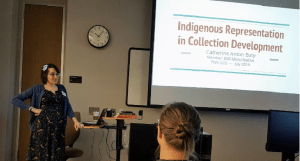When you work with children every day, you have phrases in your repertoire that you don’t give much thought to, such as: “put a bubble in your mouth,” or “give me five.” “Sit Indian style” is another that is so familiar and oft-repeated that the idea that it might be offensive can come as a shock to some. According to Catherine Baty, an Indigenous Librarian, it is troublesome. Phrases such as “sit Indian style” and “low on the totem pole” are misrepresentations of a culture’s characteristics, providing children with an unclear and at times prejudiced depiction of the culture.
Catherine wrote her dissertation on the limited quantity and quality of indigenous literature within libraries. She is also a member of the Big Sandy Rancheria, Western Mono Nation, where she grew up in California. “I didn’t see myself represented in literature until I was 19 years old, and when I did, it felt amazing,” Catherine said. “Children having access to picture books produced and published by natives, can not only allow underrepresented children feel represented, it can develop realistic views of natives to non-natives.”
The stereotypical misrepresentations of indigenous people can still be seen today in a variety of ways: The mystical and magical Pocahontas-type who talk to the animals and trees; The blood-thirsty savages seen in John Wayne movies; or, the more complex “people of the past” view where indigenous peoples are relegated to the history books.
Indigenous people today are pushing “Own Voices,” where literature about marginalized groups is written by these groups. This movement coincides with the idea that native peoples are “still here” and not a figment of the past. Books written and published by members of native communities provide more accurate representations to the public, especially children.
“I hope that public libraries and schools develop better tagging systems so people can easily find indigenous authors,” Catherine said. “Today, if a parent came in looking for native authors, we would have to search Google. I want it to be easy for patrons and librarians to have access to this information through the catalog.”
To make sure libraries are providing the best resources for children, librarians and parents can be aware of such stereotypes as well as be informed on the best literature for children to learn and understand Native American culture, tradition, and heritage.
This blog was originally published by HCPL blogger Kelsey D.




Add a comment to: Why We Should Use “Crisscross Applesauce”